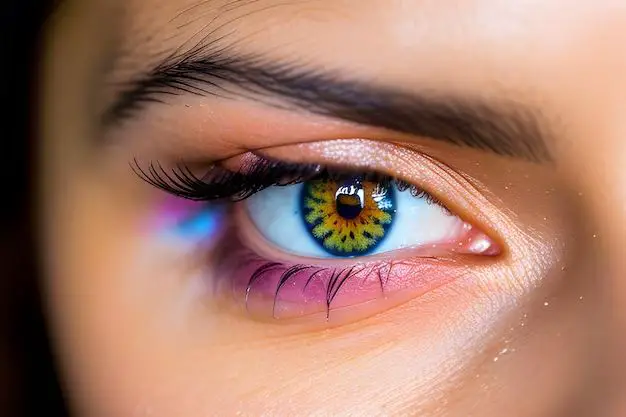Eye color preference is a complex topic with many factors influencing personal tastes and societal beauty standards. While eye color itself does not affect a person’s character or abilities, cultural biases and media portrayal shape attitudes towards certain colors being more or less desirable. Understanding the historical context and modern perceptions around eye color can shed light on prevailing notions of attractiveness.
Common Eye Colors
The most common eye colors fall into three main categories:
| Brown | Most common worldwide, especially among Asians and Africans |
| Blue | Very common among Caucasians, particularly Northern and Eastern Europeans |
| Hazel | Mix of brown and green, common in Europeans and Middle Easterners |
Other natural eye colors like gray, green, and amber occur less frequently in human populations. Albinism can also cause extremely light blue eyes due to lack of pigment. But when it comes to typical eye shades, brown, blue, and hazel account for the majority globally.
Historical Perceptions of Eye Color
Across different eras and cultures, eye color has carried symbolic meanings and associations.
Ancient Greece and Rome
In ancient Greek and Roman societies, there were generally positive associations with blue eyes, which were linked to the gods. Athena, goddess of wisdom, was often depicted with blue eyes. The epic poet Homer referred to blue eyes as signaling deeper thoughts and spirituality. Eyes that changed color with moods were seen as fascinating and mystical.
Middle Ages and Renaissance
During the Middle Ages and into the Renaissance, lighter eye colors including blue, green, and gray were generally preferred in European beauty standards. Darker eyes were seen as reflecting a connection to the soul or expressing deeper emotions and intellect. The elite often prized light eyes as rare and exotic.
Colonialism and Race
As ideas about race took shape in the modern era, Europeans promoted the superiority and purity of white traits – including light eyes. Poets like Wordsworth wrote romantic odes to blue eyes, while brown eyes were denigrated as primitive and uncivilized. Eye color became entangled with racist attitudes toward conquered peoples.
20th Century
By the 20th century, cultural biases toward lighter eyes eased as racial and ethnic diversity became more mainstream. Eye color was no longer widely seen as defining worth or beauty. As models and movie stars of varying backgrounds rose to fame, having dark brown eyes was no longer considered unfashionable.
Modern Perceptions of Eye Color Attractiveness
While explicit racism around eye color has declined, lighter eye shades still tend to be seen as rarer and more distinctive. However, perceptions vary greatly between cultures and generations.
Western Cultures
A 2014 study in the Czech Republic found that respondents considered lighter eyes more attractive, with blue being the most preferred color followed by green. This likely reflects remaining Eurocentric beauty ideals. However, another study in the U.S. found that men rated women with brown eyes as more attractive than other colors. This suggests preferences may be diversifying.
Eastern Cultures
In many Asian and African cultures, darker brown eyes have traditionally been viewed as beautiful and alluring. Lighter eyes are seen as less exotic. An Iranian study showed a strong preference for darker eyes rated as most attractive. Among African cultures, terms like “honey brown” eyes convey an ideal of beauty.
Generational Shifts
Younger generations appear to be developing more individualized and inclusive preferences around eye color attractiveness. Rather than valuing conformity to one ideal, diversity of looks is increasingly prized. Eye color on its own matters less than how striking and vivid the eyes appear in harmony with other features.
Least Favorite Eye Color Today
Given shifting societal norms, it is difficult to conclusively identify one eye color as universally least favorite today. However, some general observations indicate certain colors may be considered less attractive by wider populations in 2022.
Pale Blue
While vibrant royal or sapphire blue eyes are prized for their rarity, pale icy blue eyes can sometimes appear eerie and lacking warmth. An Irish study in 1991 found male respondents considered lighter blue eyes the least attractive.
Hazel
Hazel eyes are often perceived as relatively mundane, lacking the exotic appeal of pure brown or distinctiveness of blue eyes. Their mixed coloring draws less fascination.
Gray
Like hazel eyes, gray eyes lack the depth of pure brown or striking nature of blue. They can appear washed out or indistinct in some lighting. However, they also have fans who are drawn to their unusual grayish-green hue.
Red/Pink
While extremely rare, reddish hues resulting from albinism or medical conditions like ocular albinism are sometimes perceived as disturbing or strange given their unnatural appearance.
Conclusion
Modern notions of eye color attractiveness and undesirability have moved past outdated racial biases toward greater acceptance of diverse features. Although some colors like light blue or gray may be ranked as less appealing by some, individual preferences vary widely. A vibrant, healthy appearance and confident self-expression matter more than eye shade itself for being perceived as attractive. With shifting demographics and new generations emphasizing inclusion, eye color is likely to become even less important in defining beauty ideals.


